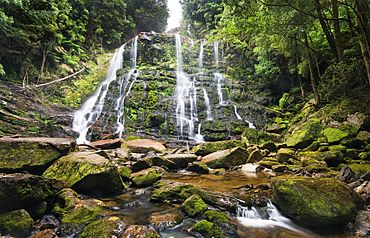Franklin-Gordon Wild Rivers National Park facts for kids
Quick facts for kids Franklin-Gordon Wild Rivers National ParkTasmania |
|
|---|---|
|
IUCN Category II (National Park)
|
|

Nelson Fall
|
|
| Nearest town or city | Strathgordon |
| Established | 1908 |
| Area | 4,463.42 km2 (1,723.3 sq mi) |
| Managing authorities | Tasmania Parks and Wildlife Service |
| Website | Franklin-Gordon Wild Rivers National Park |
| See also | Protected areas of Tasmania |
The Franklin-Gordon Wild Rivers National Park is a special place in Tasmania, Australia. It's about 117 kilometers (73 miles) west of Hobart. This park gets its name from two important rivers that flow through it: the Franklin River and the Gordon River. It's a huge area of wild nature, perfect for exploring.
Contents
Discovering the Franklin-Gordon Wild Rivers National Park
This amazing national park is found in the heart of the Tasmanian Wilderness World Heritage Area. It sits between the Central Highlands and the West Coast Range of Tasmania. Imagine a vast, untouched natural space!
Getting Around the Park
The Lyell Highway is a road that goes right through the middle of the park. It stretches for 56 kilometers (about 35 miles). This highway is the only road that crosses this wild area. It allows visitors to see some of the park's beautiful landscapes.
The Story of the Park
The Franklin-Gordon Wild Rivers National Park started as an older park called Frenchmans Cap National Park. The Franklin River was part of its boundary. Frenchmans Cap is a very noticeable mountain in the area. You can see its unique shape from many parts of the park.
Protecting the Rivers
The Gordon and Franklin Rivers became famous because of a big effort to protect them. There was a plan to build a large dam called the Franklin Dam. This dam would have created electricity but would have flooded parts of the river.
Many people, including a group called the Tasmanian Wilderness Society, worked hard to stop the dam. Their leader at the time was Bob Brown. They wanted to save the wild rivers. This became a big issue across Australia.
Because of these efforts, the rivers and their surrounding areas were given special "heritage status." This means they are protected for future generations. Even with this protection, people still work to keep these wild places safe.
Images for kids
See also
 In Spanish: Parque nacional Franklin-Gordon Wild Rivers para niños
In Spanish: Parque nacional Franklin-Gordon Wild Rivers para niños


